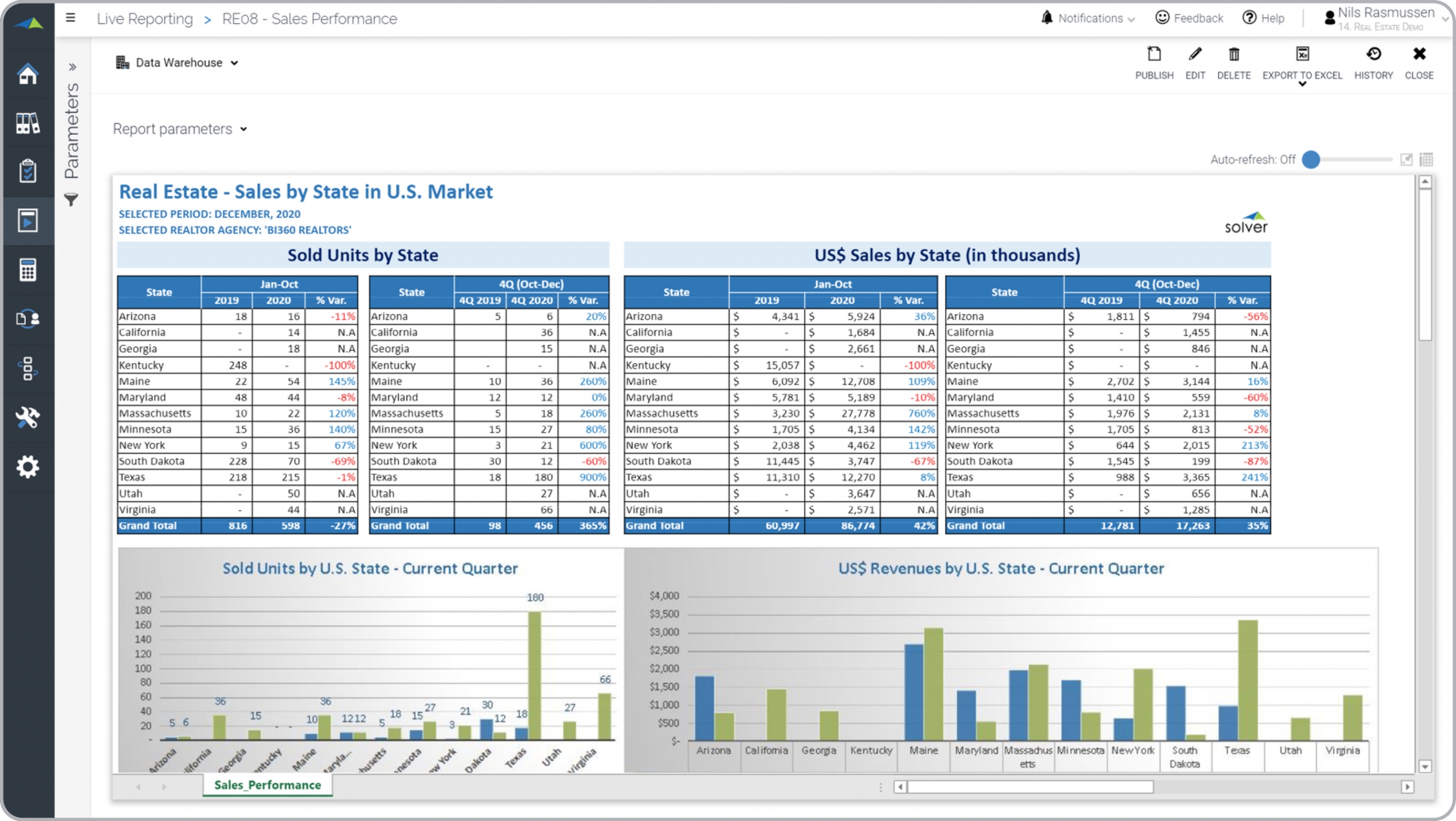Regional Sales Report for Real Estate Companies
What is a
Regional Sales Report for Real Estate Companies
? Sales Reports are considered revenue analysis tools and are used by sales executives and project development managers to track sales across territories. Some of the main functionality in this type of dashboard report is that it can be run for any year and period and will display various sales metrics by state/region. Elements of the report include: 1) Year-to-date (YTD) and Quarter-to-date (QTD) unit sales compared to prior year and with a percent variance, 2) YTD and QTD sales amounts by territory compared to prior year and with a percent variance, 3) Chart for sold units by state, 4) Chart for sales amount by state, and (not visible in the screenshot below; 5) Charts with percent unit and amount sales by state shown as variances vs prior year. You find an example of this type of dashboard report below.
Purpose of
Regional Sales Reports Real Estate companies use Regional Sales Reports to enable clear, real-time analysis that compares sales performance over historical periods and benchmarked against other states/regions/territories. When used as part of good business practices in Sales and Financial Planning and Analysis (FP&A) departments, a company can improve its project planning and sales strategies, and it can reduce the chances that managers react slow to regional performance issues (or opportunities) to due lack of comparative data.
Example of a
Regional Sales Report Here is an example of a Regional Sales Report with variance analysis and territory comparisons. [caption id="" align="alignnone" width="2560"]
 Example of a Regional Sales Report for Real Estate Companies[/caption] You can find hundreds of additional examples
here
Who Uses This Type of
Dashboard report
? The typical users of this type of dashboard report are: Sales Executives, CFOs, budget managers and executives.
Other Reports Often Used in Conjunction with
Regional Sales Reports Progressive Sales and Financial Planning and Analysis (FP&A) departments sometimes use several different Regional Sales Reports, along with sales dashboards, KPI dashboards, financial statements, annual budget models, corporate forecasts and other management and control tools.
Where Does the Data for Analysis Originate From? The Actual (historical transactions) data typically comes from enterprise resource planning (ERP) systems like: Microsoft Dynamics 365 (D365) Finance, Microsoft Dynamics 365 Business Central (D365 BC), Microsoft Dynamics AX, Microsoft Dynamics NAV, Microsoft Dynamics GP, Microsoft Dynamics SL, Sage Intacct, Sage 100, Sage 300, Sage 500, Sage X3, SAP Business One, SAP ByDesign, Acumatica, Netsuite and others. In analyses where budgets or forecasts are used, the planning data most often originates from in-house Excel spreadsheet models or from professional corporate performance management (CPM/EPM) solutions.
What Tools are Typically used for Reporting, Planning and Dashboards? Examples of business software used with the data and ERPs mentioned above are:
Example of a Regional Sales Report for Real Estate Companies[/caption] You can find hundreds of additional examples
here
Who Uses This Type of
Dashboard report
? The typical users of this type of dashboard report are: Sales Executives, CFOs, budget managers and executives.
Other Reports Often Used in Conjunction with
Regional Sales Reports Progressive Sales and Financial Planning and Analysis (FP&A) departments sometimes use several different Regional Sales Reports, along with sales dashboards, KPI dashboards, financial statements, annual budget models, corporate forecasts and other management and control tools.
Where Does the Data for Analysis Originate From? The Actual (historical transactions) data typically comes from enterprise resource planning (ERP) systems like: Microsoft Dynamics 365 (D365) Finance, Microsoft Dynamics 365 Business Central (D365 BC), Microsoft Dynamics AX, Microsoft Dynamics NAV, Microsoft Dynamics GP, Microsoft Dynamics SL, Sage Intacct, Sage 100, Sage 300, Sage 500, Sage X3, SAP Business One, SAP ByDesign, Acumatica, Netsuite and others. In analyses where budgets or forecasts are used, the planning data most often originates from in-house Excel spreadsheet models or from professional corporate performance management (CPM/EPM) solutions.
What Tools are Typically used for Reporting, Planning and Dashboards? Examples of business software used with the data and ERPs mentioned above are:
- Native ERP report writers and query tools
- Spreadsheets (for example Microsoft Excel)
- Corporate Performance Management (CPM) tools (for example Solver)
- Dashboards (for example Microsoft Power BI and Tableau)
Corporate Performance Management (CPM) Cloud Solutions and More Examples
July 2, 2021
TAGS:
Reporting,
Solver,
report writer,
Microsoft,
sales report,
template,
practice,
Acumatica,
Netsuite,
Finance,
planning,
GP,
Business Central,
state,
excel,
ax,
forecast,
Budget,
Dynamics 365,
analysis,
budgeting,
region,
Cloud,
Software,
Tableau,
SAP,
example,
best,
Sage,
BC,
D365,
NAV,
Intacct,
Variance,
Real Estate,
CPM,
report,
SL,
Management,
dynamics,
sales,
Power BI,
property,
regional sales,
sales by state,
real estate sales report

